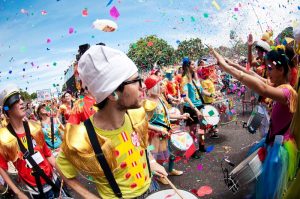By Lindenberg Junior
 The modern Brazilian Carnaval or Mardi Gras finds its roots in Rio de Janeiro in the 1830’s, when the city’s bourgeoisie imported the practice of holding balls and masquerade parties from Paris. It originally mimicked the European form of the festival, over time acquiring elements derived from African and Amerindian cultures. During the Carnival, a fat man is traditionally elected to represent the role of “Rei Momo”, the “King” of Carnaval.
The modern Brazilian Carnaval or Mardi Gras finds its roots in Rio de Janeiro in the 1830’s, when the city’s bourgeoisie imported the practice of holding balls and masquerade parties from Paris. It originally mimicked the European form of the festival, over time acquiring elements derived from African and Amerindian cultures. During the Carnival, a fat man is traditionally elected to represent the role of “Rei Momo”, the “King” of Carnaval.
Internationally, Rio is considered the national Brazilian Carnaval symbol. Organized and impromptus celebrations is everywhere, but the Samba School Parade with many groups and floats, drummers and dancers in glittering, required, feathered costumes in front of your eyes is a must in lifetime. It is like watching Las Vegas on wheels. Premier and legendary samba schools like Mangueira. Salgueiro, Portela, Beija-flor and Mocidade Independente among others energize the crowd and brought them to their feet when they start sing they samba enredo (theme song).
The state of Bahia with their frenetic rhythms including samba-reggae and afoxé, plus state of Pernambuco with their unique Frevo style and Maracatu Afro rhythms has been taking for a while part of the “Carnaval Cake”. In both cases Carnaval is a time for total participation. City residents and visitors dance together until dawn. This openness makes Bahia and Pernambuco Carnival different from Rio and other celebrations in Brazil.![]()
In Salvador, capital of Bahia, on the second part of the 19th century; the black population celebrated the days of carnaval in its own way, highly marked by African-Yoruba characteristics, dancing in the streets playing Afro instruments, By the 70’s, three main types of carnaval groups developed in Bahia: Electric Trios, Blocos Afros and Afoxés.
Electric Trios are characterized by an adapted truck with giant speakers with a platform where musicians play Afro style song with the inclusion of electric guitars and other acoustic instruments. Enthusiastic folks follow the trucks singing and dancing. Blocos Afros were influenced by the black pride movement in the U.S, independence movements in Africa, and reggae music that denounced racism and oppression. The groups inspired a renewed pride in Africa heritage. The Blocos Afros entities formed especially during carnival which parade in the streets, dressed uniformly according to a theme. The afoxés are special blocos formed by people who belong to Candonblé houses.
Pernambuco for a while has been recognized as a hot spot for the street carnaval celebrations in the capital Recife as well small cities as Olinda, Bezerros and Nazaré da Mata. In the historic city of Olinda (declared by Unesco as historical and cultural heritage of mankind) the celebrations starts one week earliest and the attractions is the many carnaval groups with funny names such as: “Tell me you love me, Damn it”, “The Midnight Man” (with a famous giant dancing doll that leads the group), “Crazy Lover” and “Olinda’s Underpants” among others.
![]() In Bezerros, the carnival start ten days earliest with the formal Municipal Ball on Wednesday followed in the wee hours of morning by the “Wake Up Bezerros” revelry, when revelers leave their homes to celebrate in their pajamas or other nightwear. Still on the previous week, there is a Fellini-like “Pedalando o Papangú” for masked bike riders. Fat Tuesday there is a lively soccer match where all of the players must wear masks. Bezerros is the land of “Papangús” or “Masquerades”.
In Bezerros, the carnival start ten days earliest with the formal Municipal Ball on Wednesday followed in the wee hours of morning by the “Wake Up Bezerros” revelry, when revelers leave their homes to celebrate in their pajamas or other nightwear. Still on the previous week, there is a Fellini-like “Pedalando o Papangú” for masked bike riders. Fat Tuesday there is a lively soccer match where all of the players must wear masks. Bezerros is the land of “Papangús” or “Masquerades”.
In Nazaré da Mata you will find the original Afro-Brazilian unique rhythmus of Maracatu that includes Maracatu Nação (nation-style maracatu) and Maracatu Rural (rural-style maracatu).
The freedom to party in the streets is a unique experience for all and in special for those that are not Brazilians. It seemed like the whole city had come to a stop to join in the spirit of Carnaval. Simply, if you have never been to a carnaval in Brazil, particularly in Bahia and Pernambuco, there is no way you can fully understand the carnaval vibe and parties.
